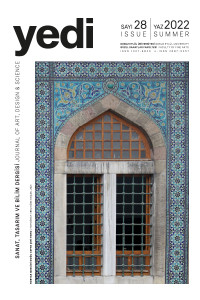Öz
Bu makale sibernetiğin felsefi altyapısını inceleyerek yeni medya estetiği bağlamında performatiflik kavramını yeniden formüle ediyor. Bilgi işleme ve üretme sistemleri, öz-düşünümsel elektronik ve dijital döngüler, karmaşıklık, dinamizm ve özerk olarak gelişen sistemler gibi sibernetik kavramlar aracılığıyla performatiflik kavramını yeni medya estetiği ışığında açıklıyor ve yeni medya teknolojilerinin operasyonel mantığı ve altyapısının ancak performatif bir bakış açısıyla anlaşılabileceğini savunuyor. Performans terimi, temel olarak, sistemlerin oluşturulmasını ve dönüştürülmesini, onları eyleme geçirerek yöneten hareketi ifade eder. Bu eylem aracılığıyla, bir sistemin çeşitli bileşenleri ve parçaları bilgileri ileterek karmaşık etkileşimli sistemler üretir. Sonuç olarak, bu tür karmaşık etkileşimler yeni formların ortaya çıkmasına neden olur. Bu karmaşık sistemlerin yeni kodlar, konfigürasyonlar ve formlar üretmesi bu şekildedir. Böyle bir formülasyon, sonunda yeni medya teknolojilerinin ve estetiğinin temel özelliklerinin daha iyi anlaşılmasına yol açabilecek melez bir çerçeveyi tanımlamak için bir başlangıç noktası oluşturuyor. Tek, ayrık ve birbiriyle bağlantısı olmayan mekanik araçlardan teknolojik sistemlere geçişle birlikte yeni bir estetik anlayışın temelleri atıldı. Bilgi ve iletişim teknolojilerinin mümkün kıldığı yeni medya estetiği sanat eserini tek, bağımsız ve somut bir nesne olarak incelemektense sanat eserinin kendisinin ortam ve mecra olduğunu ve estetik olanın sanat nesnesi yerine ortam ve mecranın kendisi olarak düşünülebileceğini gösterdi. Bu makale yeni medya kavramını mecra ve dolayımlama kavramları üzerinden temellendirerek yeni medya sanatının yarattığı estetik anlayışı sistemler ve ağlar bağlamında tartışmaktadır. Bu makalede kullanılan metod literatür tarama ve değerlendirmedir.
Anahtar Kelimeler
Kaynakça
- Bolter, J. D. & Grusin, R. (2000). Remediation: Understanding new media. MIT Press.
- Burnham, J. (1968). Systems esthetics. Artforum, 7(1), 30-35. https://www.artforum.com/print/196807/systems-esthetics-32466
- Castells, M. (1996). The Rise of the network society, the information age: Economy, society and culture Vol. I. Blackwell.
- Clark, A. & Chalmers, D. (1998). The Extended Mind. Analysis, 58(1), 7-19. http://www.jstor.org/stable/3328150
- Clarke, B. & Hansen, M. (2009). Emergence and embodiment: New essays on second-order systems theory. Duke University Press.
- Halsall, F. (2008). Systems of art: Art, history, and systems theory. Peter Lang.
- Hayles, N. K. (1999). How we became posthuman: Virtual bodies in cybernetics, literature, and informatics. University of Chicago Press.
- Johnston, J. (2008). The allure of machinic life: Cybernetics, artificial life and the new AI. Bradford Books.
- Karatani, K. (1995). Architecture as metaphor; language, number, money. MIT Press.
- Kittler, F. (1992). Discourse networks 1800/1900 (M. Metteer and C. Cullens, Trans.). Stanford University Press.
- Latour, B. (2002). Reassembling the social: An introduction to actor-network theory. Oxford University Press.
- Pickering, A. (2010). The cybernetic brain: Sketches of another future. University of Chicago Press.
Öz
By drawing upon philosophical repercussions of cybernetics, this article reformulates the notion of performativity in the context of new media aesthetics. It links performativity to new media aesthetics via the cybernetic notions of information processing and generating systems, recursive electronic and digital feedback loops, emergency, complexity, dynamism, and autonomously evolving systems. In doing so, I argue that the operational logic and infrastructure of new media technologies can only be understood from a performative perspective. The term performance basically refers here to the movement which governs the generation and transformation of systems by putting them into action. It is through this action that the various components and parts of a system relay and process information and produce complex interactive systems. As a result, this kind of complex interactivity leads to the emergence of new forms. It is in this way that these complex systems produce new codes, configurations, and constellations. Such a formulation constitutes my starting point to describe a hybrid framework that may eventually lead to a better understanding of the essential characteristics of new media technologies and aesthetics. The shift from single, discrete, and isolated mechanical artifacts to technological systems laid the foundations for a new kind of aesthetics, the aesthetics of information processing and generating systems. The study of the art object as a system or an environment rather than a single object is crucial to address the way in which the system itself might be conceived of as an aesthetic medium. I foreground my definition of new media in the notions of medium and mediation and discuss the aesthetic possibilities brought forth by the emergence and advancement of information and communication technologies. The method used in this article is literature review.
Anahtar Kelimeler
New Medİa Aesthetics Cybernetics Systems Networks Information
Kaynakça
- Bolter, J. D. & Grusin, R. (2000). Remediation: Understanding new media. MIT Press.
- Burnham, J. (1968). Systems esthetics. Artforum, 7(1), 30-35. https://www.artforum.com/print/196807/systems-esthetics-32466
- Castells, M. (1996). The Rise of the network society, the information age: Economy, society and culture Vol. I. Blackwell.
- Clark, A. & Chalmers, D. (1998). The Extended Mind. Analysis, 58(1), 7-19. http://www.jstor.org/stable/3328150
- Clarke, B. & Hansen, M. (2009). Emergence and embodiment: New essays on second-order systems theory. Duke University Press.
- Halsall, F. (2008). Systems of art: Art, history, and systems theory. Peter Lang.
- Hayles, N. K. (1999). How we became posthuman: Virtual bodies in cybernetics, literature, and informatics. University of Chicago Press.
- Johnston, J. (2008). The allure of machinic life: Cybernetics, artificial life and the new AI. Bradford Books.
- Karatani, K. (1995). Architecture as metaphor; language, number, money. MIT Press.
- Kittler, F. (1992). Discourse networks 1800/1900 (M. Metteer and C. Cullens, Trans.). Stanford University Press.
- Latour, B. (2002). Reassembling the social: An introduction to actor-network theory. Oxford University Press.
- Pickering, A. (2010). The cybernetic brain: Sketches of another future. University of Chicago Press.
Ayrıntılar
| Birincil Dil | İngilizce |
|---|---|
| Bölüm | Araştırma Makaleler |
| Yazarlar | |
| Erken Görünüm Tarihi | 10 Ocak 2022 |
| Yayımlanma Tarihi | 28 Temmuz 2022 |
| Gönderilme Tarihi | 7 Eylül 2021 |
| Kabul Tarihi | 11 Ocak 2022 |
| Yayımlandığı Sayı | Yıl 2022 Sayı: 28 |
This work is licensed under a Creative Commons Attribution 4.0 International License.


